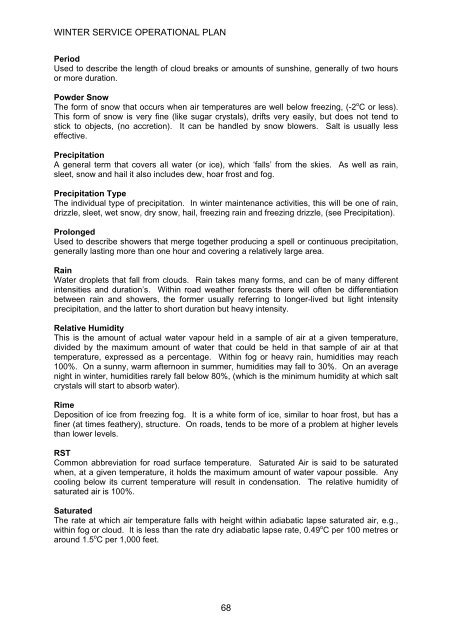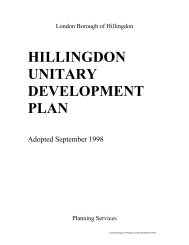Report - London Borough of Hillingdon
Report - London Borough of Hillingdon
Report - London Borough of Hillingdon
You also want an ePaper? Increase the reach of your titles
YUMPU automatically turns print PDFs into web optimized ePapers that Google loves.
WINTER SERVICE OPERATIONAL PLAN<br />
74BPeriod<br />
Used to describe the length <strong>of</strong> cloud breaks or amounts <strong>of</strong> sunshine, generally <strong>of</strong> two hours<br />
or more duration.<br />
75BPowder Snow<br />
The form <strong>of</strong> snow that occurs when air temperatures are well below freezing, (-2 o C or less).<br />
This form <strong>of</strong> snow is very fine (like sugar crystals), drifts very easily, but does not tend to<br />
stick to objects, (no accretion). It can be handled by snow blowers. Salt is usually less<br />
effective.<br />
76BPrecipitation<br />
A general term that covers all water (or ice), which ‘falls’ from the skies. As well as rain,<br />
sleet, snow and hail it also includes dew, hoar frost and fog.<br />
7BPrecipitation Type<br />
The individual type <strong>of</strong> precipitation. In winter maintenance activities, this will be one <strong>of</strong> rain,<br />
drizzle, sleet, wet snow, dry snow, hail, freezing rain and freezing drizzle, (see Precipitation).<br />
78BProlonged<br />
Used to describe showers that merge together producing a spell or continuous precipitation,<br />
generally lasting more than one hour and covering a relatively large area.<br />
79BRain<br />
Water droplets that fall from clouds. Rain takes many forms, and can be <strong>of</strong> many different<br />
intensities and duration’s. Within road weather forecasts there will <strong>of</strong>ten be differentiation<br />
between rain and showers, the former usually referring to longer-lived but light intensity<br />
precipitation, and the latter to short duration but heavy intensity.<br />
80BRelative Humidity<br />
This is the amount <strong>of</strong> actual water vapour held in a sample <strong>of</strong> air at a given temperature,<br />
divided by the maximum amount <strong>of</strong> water that could be held in that sample <strong>of</strong> air at that<br />
temperature, expressed as a percentage. Within fog or heavy rain, humidities may reach<br />
100%. On a sunny, warm afternoon in summer, humidities may fall to 30%. On an average<br />
night in winter, humidities rarely fall below 80%, (which is the minimum humidity at which salt<br />
crystals will start to absorb water).<br />
81BRime<br />
Deposition <strong>of</strong> ice from freezing fog. It is a white form <strong>of</strong> ice, similar to hoar frost, but has a<br />
finer (at times feathery), structure. On roads, tends to be more <strong>of</strong> a problem at higher levels<br />
than lower levels.<br />
RST<br />
Common abbreviation for road surface temperature. Saturated Air is said to be saturated<br />
when, at a given temperature, it holds the maximum amount <strong>of</strong> water vapour possible. Any<br />
cooling below its current temperature will result in condensation. The relative humidity <strong>of</strong><br />
saturated air is 100%.<br />
Saturated<br />
The rate at which air temperature falls with height within adiabatic lapse saturated air, e.g.,<br />
within fog or cloud. It is less than the rate dry adiabatic lapse rate, 0.49 o C per 100 metres or<br />
around 1.5 o C per 1,000 feet.<br />
68
















